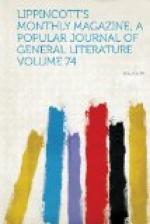[Illustration: CHURCH AND CONVENT OF SAINT FRANCIS, AT ASSISI.]
The cliff on which Assisi stands rises abruptly on the side toward the Tiber: long lines of triple arches, which look as if hewn in the living stone, stretch along its face, one above another, like galleries, the great mass of the church and convent, with its towers and gables and spire-like cypress trees, crowning all. It is this marriage of the building to the rock, these lower arcades which rise halfway between the valley and the plateau seeking the help of the solid crag to sustain the upper ones and the vast superimposed structure, that makes the distant sight of Assisi so striking, and almost overwhelms you with a sense of its greatness as the winding road brings you close below on your way up to the town. It is a triple church. The uppermost one, begun two years after the saint’s death, has a magnificent Gothic west front and high steps leading from the piazza, and a rich side-portal with a still higher flight leading from a court on a lower level. As we entered, the early afternoon sun was streaming in through the immense rose-window and flooding the vast nave, illumining the blue star-studded vault of the lofty roof and the grand, simple frescoes of Cimabue and Giotto on the walls. Thence we descended to the second church, in whose darkness our vision groped, half blind from the sudden change; but gradually through the dusk we began to discern low vaults stretching heavily across pillars which look like stunted giants, so short are they and so tremendously thick-set, the high altar enclosed by an elaborate grating, the little side-chapels like so many black cells, and through the gloom a twinkle and glimmer of gold and color and motes floating in furtive sunbeams that had strayed in through the superb stained glass of the infrequent windows. The frescoes of Giotto and his school enrich every spandril and interspace with their simple, serious forms—no other such place to study the art of that early day—but a Virgin enthroned among saints by Lo Spagna, a disciple of Perugino’s, made a pure light in the obscurity: it had all the master’s golden transparency, like clear shining after the rain. From this most solemn and venerable place we went down to the lowest church, the real sepulchre: it was darker than the one we had left, totally dark it seemed to me, and contracted, although—it is in the form of a Greek cross—each arm is sixty feet: in fact, it is only a crypt of unusual size; and although here were the saint’s bones in an urn of bronze, we were conscious of a weakening of the impression made by the place we had just left. No doubt it is because the crypt is of this century, while the other two churches are of the thirteenth.




